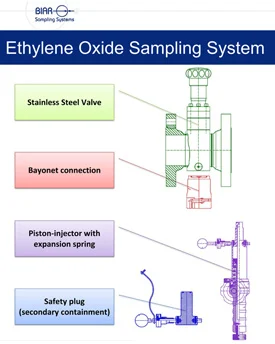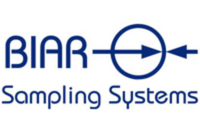A Simpler & Better Alternative to Traditional Sample Collection Methods
Ethylene Oxide (EO) is an extremely flammable and volatile substance and is considered a potential occupational carcinogen by the National Institute for Occupational Safety and Health (NIOSH). It must be sampled in an enclosed environment to prevent exposure and releases into the environment. Sample receptacles must be designed to allow for product expansion, as EO has a high rate of thermal expansion.
Why Sample EO
- To ensure product purity
- To determine water content
What to Look for in the Sample
- Product purity, based on readings from a gas chromatograph
- Water content, using the Karl Fisher titration method
How to Take the Best EO Sample
- BIAR Multi-Function 316SS inline sample valve with spring-to-close function
- BIAR Cylinder or BIAR Piston Injector
- Bayonet Adapter (for connecting BIAR Cylinder to the valve)
- Safety Plug (secondary containment)

The safest way to sample EO is by installing a sample valve on a vertical pipeline or at a 90-degree angle on a horizontal pipeline to allow vapor space in the sample cylinder for product expansion. Consult this page to understand how BIAR COLUMBIA-LY sample cylinders provide sufficient vapor space to prevent the occurrence of over-pressure from volumetric expansion.
Alternatively, a BIAR Piston Injector can be used with a BIAR inline sample valve to draw a sample directly from the process line. The piston injector is fitted with a spring behind the piston to allow expansion of the ethylene oxide as the temperature increases.
Both options are devoid of connectors, hoses or quick connects and can be designed to extract the sample directly to laboratory equipment for analysis.
Advantages of our sampling solutions compared to alternatives such as sample panels and cylinders with dip tubes, include:
- Safer
- Simpler
- More Robust
- Fewer Potential Leak Points
- Fewer Potential Contamination Sources
Ethylene Oxide
1) Description
Name: .............................................................................................Ethylene Oxide
Chemical Formula: ...................................................................C₂H₄O
CAS No: .........................................................................................75-21-8
Other Names: .............................................................................oxiran, oxirane
Uses: ...............................................................................................Industrial
Physical state: ............................................................................Gas/Liquid
Color: ..............................................................................................Colorless
Odor: ..............................................................................................ether-like
Boiling Point: ..............................................................................10.5 °C (51°F)
Flash Point: ..................................................................................-29°C (-20 °F) liquid
Flammability (solid, gas): .....................................................3 - 100 vol %
Vapor pressure: .........................................................................1.46 atm
2) Hazards
Immediately Dangerous to Life or Health Concentrations (IDLH) (NIOSH) 1994
This material is considered hazardous by the OSHA Hazard Communication Standard (29 CFR 1910.1200).
Reactivity: Strong acids, alkalis and oxidizers, water.
Specific Hazards related to Sampling: EO is an extremely flammable and volatile substance and considered an occupational carcinogen by NIOSH and the EPA. Sample systems must be designed so that emissions, exposure and potential accidental releases are minimized. Systems that are devoid of dead space are preferred, as product buildup can compromise sample system operation. EO also has a high rate of thermal expansion, so a suitable sampling receptacle that allows for product expansion after sampling is necessary to avoid any buildup of pressure.
![]()
3) Sampling Facts
Ethylene Oxide must be sampled in an enclosed environment due to its toxicity and flammability. The sample receptacle must also allow for product expansion using a pressure relief mechanism (not recommended) or a suitable receptacle which allows for product expansion within it.
Plants need to verify the purity of the product and for moisture throughout the process.
Measure for purity using a Gas chromatograph and water content using the Karl Fisher titration method.
4) Most common Sample Receptacles
Sample cylinders which feature a dip tube that allows for product expansion are used widely in the industry. These are generally mounted on a ‘sample panel’ type system on a bypass off the main line. These feature multiple connections, hoses and quick connects and as a result are not robust and offer many potential leak points. We have come across these systems in many applications and the same problems continue to persist. Also, for processes sensitive to moisture, these systems offer many potential sources of contamination due to condensation. A better alternative is the BIAR Cylinder or Piston Injector which are used with a sample valve mounted directly on the process line. Not only is the sample representative as the sample is taken directly from the process line, it is a safer, simpler and more robust system with less potential leak points or sources for contamination.


